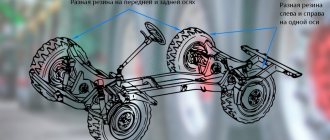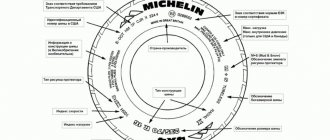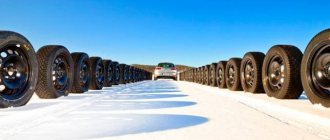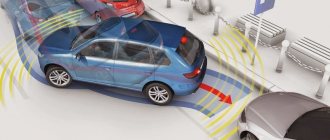Weather conditions suitable for changing tires
If you take into account only weather conditions, it is recommended to adhere to the following rules:
- dry or wet road - summer or all-season tires;
- road covered with snow - winter;
- road covered with ice - studded.
But it is recommended to install winter tires before the snow falls, also taking into account the ambient temperature. As a rule, on the tires themselves, the manufacturer independently indicates the optimal conditions for their operation - they should be adhered to. In most cases, winter tires retain their properties at temperatures of +7 °C or below, and summer tires retain their properties at temperatures of +7 °C or above.
What happens if you use summer tires in the cold? It will lose its elasticity, the tread will be excessively hard, which will cause poor grip on the road surface. And when performing a maneuver, there is a high risk of slipping or skidding.
With winter everything is a little different. At temperatures above +7 °C it becomes too soft. The grip on the road surface is excellent, but the tread wears out very quickly. Accordingly, in such conditions, tires can only be used for 3–4 months, after which their further use is dangerous.
Proper installation of winter tires: tips for car enthusiasts
In the winter season, for the safe operation of a car, the highest quality winter tires are required, guaranteeing better traction on snow both during acceleration and braking. But to guarantee safety, you still need to install winter tires as competently as possible.
First of all, it is important to check the beads of winter tires for foreign inclusions, such as nails or glass debris. Otherwise, you will have to re-flare the wheels.
There are certain subtleties in installing winter tires
Tires must be installed correctly - the arrows on the sides must point forward. Otherwise, the protector, made in a unique herringbone pattern, will not be able to clean itself. In snowy conditions, there will be a risk that the winter tire will simply lose grip.
Winter tires need high-quality dry air. If the air from under the compressor is slightly humid, then it runs the risk of turning into condensation and then into ice when freezing temperatures set in, which will lead to failure of the winter tire. To reduce the risk, it is better to buy in advance a portable tire compressor that operates from a cigarette lighter at a voltage of 12 V. These compressors are valuable not only for their compactness and power, but also for their ability to generate only clean, dry air, which makes them simply irreplaceable in winter realities.
<<How to choose a compressor for inflating tires?>>
Winter tires are also available with studded ones. The latter are screwed into steel spikes, which can guarantee the most reliable grip on icy roads. The car will never skid when accelerating or braking sharply. But on one condition - that the spikes will not fly out of their landing lamellas. To prevent this from happening in principle, studded tires, purchased in a store or assembled by hand, must first be run-in (see how run-in is done ), that is, driving at reduced speeds.
Studded tires, especially those with larger diameters, can touch the inside of the fenders. This must be taken into account when installing them. Or do not overload the car in the future.
And of course, any type of winter tires must be subjected to final or computer balancing after installation, that is, a process where the wheels are perfectly aligned. In the first case, the car is lifted on a lift and all wheels accelerate to 120 km/h, while in the latter version the wheel balance is on a special machine. The car's suspension will no longer break, and the driver will move much more confidently on highways.
When to change tires to winter according to Russian law
The Russian traffic regulations do not clearly indicate when tires need to be changed. There are only the following requirements:
- during the period from December to February inclusive, winter tires with the appropriate marking must be installed on a motor vehicle (vehicle);
- the use of studded tires in any period other than winter is prohibited;
- The tread pattern of the front and rear wheels must be identical;
- It is prohibited to install studded tires only on the front or rear wheels, even if the car has only one drive axle;
- the residual depth of the pattern on a winter or studded tire must be more than 4 mm; if less, operation of the vehicle is prohibited until the malfunction is eliminated.
The news has repeatedly talked about the submission of a bill to the State Duma, according to which an exact period for mandatory tire replacement will be established, but so far there has been no progress in resolving this issue.
In which direction should you install Continental tires?
The products of the German corporation are in great demand among Russian buyers. The manufacturer's product range includes asymmetrical and directional designs. According to European standards, in 100% of cases there are indicator elements on the tire that facilitate correct installation.
All the inscriptions and arrows present will help you to trim the ramp as accurately as possible.
What tires are suitable for winter
According to current laws, in winter it is allowed to operate vehicles with the following types of tires:
- winter ones with appropriate markings;
- studded;
- all-season, if there is a marking allowing operation in winter.
However, all-season tires, as practice shows, provide poorer traction with the road surface in the cold season. At the legal level, there are no fines for their use, but experienced drivers do not recommend using them from a safety point of view.
What is the difference between a winter tire and an all-season tire? The latter has a less pronounced and branched pattern. And in composition it is more similar to summer tires; on snowy or icy roads, traction deteriorates significantly.
Which side should you put the tire on the car rim?
Experienced motorists know that each tire has a direction of rotation.
If you put the wheel on the car incorrectly, its efficiency is greatly reduced. Tread wear also increases, which leads to rapid wear of the studs and increased movement noise. Special inscriptions such as Rotation, Outside will help you find out which side to put the tires on the car. Designations are applied to the sidewalls, and the indices are relevant for all manufacturers. Regardless of the brand, be it Hankuk or Rossava, the labeling is the same.
Rules for using winter tires
Inexperienced drivers are advised to install studded tires a little earlier than expected, when the average daily ambient temperature drops to 8–9 °C. But when the roads are completely covered with snow or ice, it is better to use studded ones. This should not be used on clean asphalt - the stability of the car decreases, and you get a kind of skating effect.
You should not skimp on winter tires, and it is better to use all four wheels. Before the first trip, you need to make sure that it is working, that is, the tread depth is suitable, the pattern is uniform, and there is no asymmetric wear.
But as for storage, the best conditions for winter tires are garage conditions, but in a dry box or room. And be sure to protect from direct sunlight.
What tires are better to use before the onset of cold weather? The best option is a winter one, but it would be a good idea to take anti-slip chains with you. But in many countries it is completely prohibited to use studded tires - if you try to go through customs, you will receive a ban.
What's the point?
Marking of winter tires
The Winter Tire Law regulates the operating permits for vehicles. The main innovation concerns the depth of tire treads, if there is no wear indicator on the surface of the specified product. If there is a factory wear indicator, the degree of suitability of the products is established according to the indicator. The decree specifies the marking of winter tires and introduces a pictogram with a snowflake in the center. From these documents the following general conclusions can be drawn:
- In summer it is unacceptable to drive on studded tires. Winter studded products marked “M+S” can be used from the onset of autumn until the end of spring. Those. in June, July and August you can only ride on summer, all-season or Velcro without studs.
- In winter, you are only allowed to drive on winter tires. It is allowed to install studded or non-studded tires that have the appropriate pictogram, marked “M+S”, “M&S” or “MS”. Disclaimer: non-studded products can be used all year round. The remaining tread depth must be at least 4mm.
- All-season tires are usually used all year round if they have the following markings on their surface: “M+S”, “M&S” or “MS”. Without these designations, products cannot be used in winter.
- The ability of local authorities to extend the service life of a certain type of tire is indicated. At the same time, regional authorities cannot reduce the period established by law.
See Table 1 for the period when you need to change tires.
Table 1. Seasonality of various types of tires.
| Terms of use (months) | Summer tires | Winter tires (if marked accordingly) | |
| studded | studless | ||
| December-February | — | + | + |
| March-May | + | + | + |
| June August | + | — | + |
| September-November | + | + | + |
From the table data you can see when you need to switch to a new type of tire, depending on the seasonality of the product.
We recommend watching a video about the law on winter tires:
Tips for installing winter tires
When is the best time to install winter tires? The generally accepted “folk” date is November 15. But this is only relevant for regions located in the temperate climate zone. Otherwise, they are guided by weather conditions and the average daily ambient temperature.
Before installing winter tires, it is recommended to have the wheels balanced. It is even better to carry out maintenance of the entire suspension.
You should also give preference to stamped steel disks - they do not get clogged with snow so quickly. It is advisable to install protective plastic caps of a closed type.
Thus, the car should be “shoeed” according to the season. Not because a fine may be issued for violating this rule, but for the safety of the road user himself. But there are no all-season tires suitable for use in the Russian Federation. Scientists have not yet been able to develop rubber that would retain its same elasticity at temperatures from -30 to +80 °C.
Tire direction when installing Pirelli
Most of the company's new skate models are made asymmetrically. The main feature of the working area is that the inside is made soft. At the same time, the outer part is rigid. This gives the car more stability when cornering and improves straight-line stability.
Regarding the correct installation, just study the inscriptions on the walls and act according to the factory instructions.
Note! Some products are divided into right and left (there are additional indices). This fact must be taken into account during boarding.











